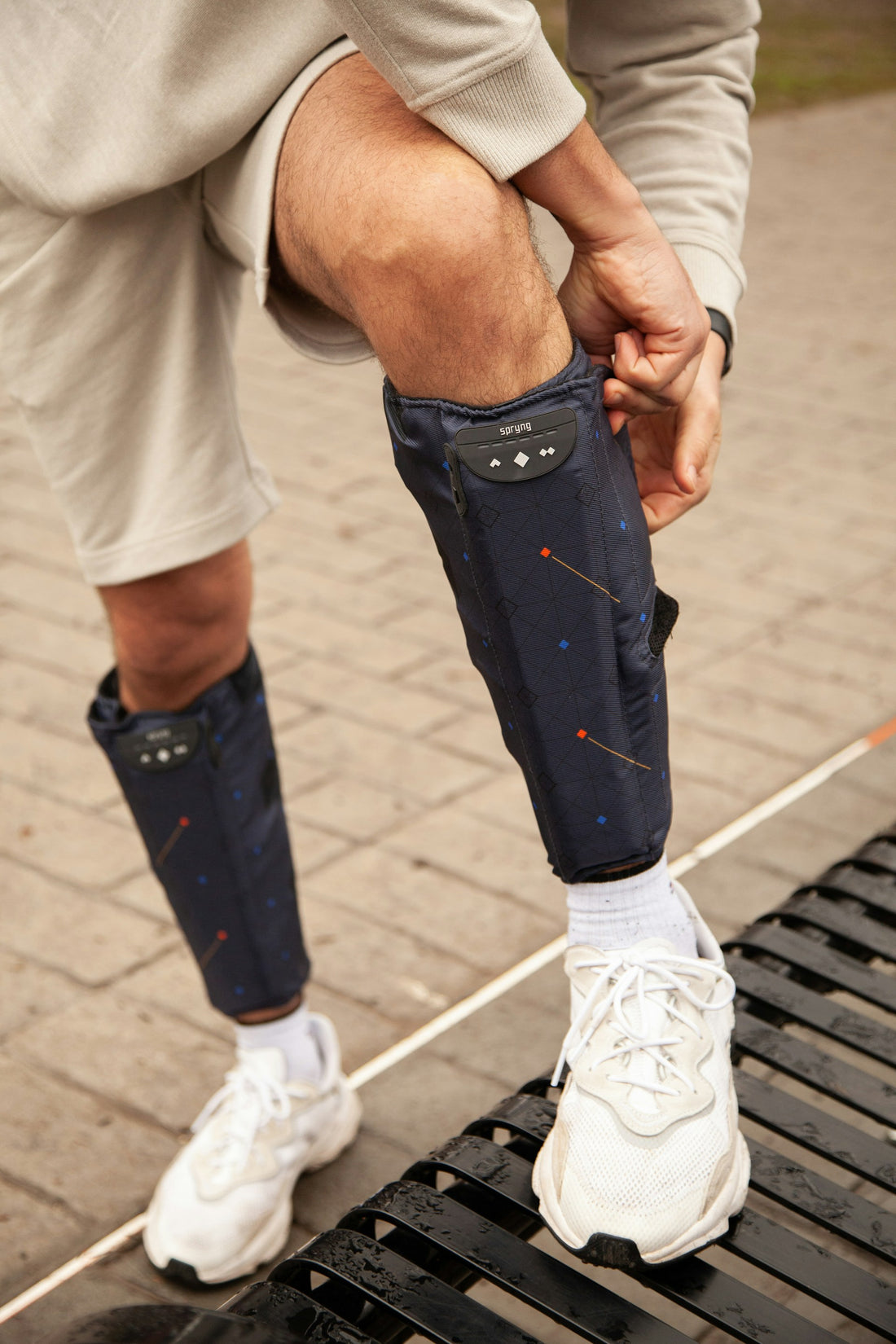
Are Copper Fit Compression Socks Good for Diabetics?
Share
Introduction
In the landscape of health and wellness, compression socks have risen to prominence as an invaluable asset for enhancing circulation and mitigating swelling, particularly for individuals grappling with specific medical conditions such as diabetes. Among the plethora of options that have captivated the market's attention, Copper Fit compression socks stand out, offering the dual benefits of compression therapy and the purported advantages of infused copper. This raises the question: how effective are these specialized socks for diabetics? This exploration seeks to shed light on the efficacy and benefits of Copper Fit compression socks for individuals with diabetes.
Understanding Compression Socks
How They Work
Compression socks are ingeniously crafted to foster blood flow and enhance circulation by exerting gentle pressure on the lower legs. This mechanism is pivotal in preventing the stagnation of blood in the feet, a predicament commonly faced by individuals who spend considerable time in stationary positions, whether standing or sitting. The gradient pressure applied from the ankle upwards supports the veins in moving blood back towards the heart, countering the effects of gravity and improving overall vascular health.
Benefits for General Health
The utility of compression socks extends far beyond the realm of improved circulation. They are celebrated for their capacity to diminish swelling, soothe discomfort, and avert the development of varicose veins. For the wider population, these socks serve as a straightforward and efficacious method to preserve the health of their legs, offering a preventive measure against a range of circulatory problems. The compression provided helps to stabilize the muscle and reduce vibrations during movement, which can also contribute to reduced fatigue and enhanced performance in daily activities and exercise.

The Diabetic Condition
Circulatory Challenges
Diabetes poses significant challenges to circulatory health, primarily due to its capacity to precipitate a range of complications, such as peripheral neuropathy and an elevated risk of developing foot ulcers. These complications arise from the detrimental impact of elevated blood sugar levels on blood vessels, which can lead to vascular damage, impede circulation, and diminish the body's wound-healing capabilities. The compromised blood flow exacerbates the risk of infections and can lead to severe outcomes if not adequately managed. For individuals with diabetes, maintaining optimal circulation is crucial to prevent these dire health issues and ensure the health and well-being of their lower extremities.
In this context, the exploration into the suitability and benefits of Copper Fit compression socks for diabetics becomes not only relevant but essential, as these individuals navigate through the complexities of managing their condition while seeking to uphold their circulatory health.
Importance of Proper Foot Care
For individuals with diabetes, the importance of proper foot care cannot be overstated. Given the heightened risks associated with the condition, such as impaired circulation and nerve damage, meticulous attention to foot health is crucial. Regular inspection of the feet for any cuts, sores, or changes in skin color is essential, as even minor injuries can escalate into severe complications if unnoticed. Maintaining cleanliness and hygiene, keeping the feet dry to prevent fungal infections, and selecting appropriate, supportive footwear are fundamental practices. Compression socks, by enhancing circulation and offering support, play a significant role in a comprehensive foot care regimen for diabetics, aiding in the prevention of common diabetic foot complications.
Copper Fit Compression Socks
Features of Copper Fit
Copper Fit compression socks distinguish themselves by integrating the benefits of compression technology with the antimicrobial properties of copper. This innovative combination offers a dual advantage. The compression aspect promotes increased blood flow and reduces swelling, essential for individuals with circulatory challenges. Simultaneously, copper, a metal known for its ability to inhibit the growth of bacteria, molds, and fungi, adds a layer of protection against infections. This feature is particularly beneficial for diabetics, whose healing processes may be compromised, making them more susceptible to infections.
How Copper Fit Aids Diabetics
For diabetics, Copper Fit compression socks represent a significant advancement in supportive foot care. The socks’ ability to improve circulation addresses one of the core challenges of diabetic health—maintaining optimal blood flow to the lower extremities. Moreover, the copper-infused fabric offers a passive defense against microbial infections, a critical concern for individuals with diabetes, as their wounds heal more slowly and are prone to infection. This combination makes Copper Fit compression socks an attractive option for diabetics seeking to protect their foot health while benefiting from the general advantages of compression therapy.
Scientific Backing
Studies on Compression Therapy
The effectiveness of compression therapy in managing symptoms associated with poor circulation has been the subject of numerous scientific studies. These investigations have consistently demonstrated the benefits of compression garments in improving blood flow, reducing edema, and preventing venous disorders. Although specific research on Copper Fit compression socks may be more limited, the general consensus within the scientific community supports the use of compression wear for enhancing circulatory health. The addition of copper’s antimicrobial properties further underscores the potential health benefits of Copper Fit socks, particularly for diabetics, highlighting the importance of considering both traditional and innovative approaches in managing the condition.
Copper's Antimicrobial Properties
The antimicrobial properties of copper are well-documented, with the metal known to reduce the growth of bacteria, viruses, and fungi on surfaces. This characteristic of copper adds a layer of protection, particularly beneficial for individuals with diabetes, who are at an increased risk of infection due to slower wound healing processes. The incorporation of copper into compression socks capitalizes on these antimicrobial properties, suggesting that these garments could provide not only circulatory support but also an added defense against potential infections. This dual functionality enhances the appeal of Copper Fit compression socks as a preventative health measure, offering diabetic individuals an additional safeguard in managing their foot health.

User Experiences
Testimonials
The positive impact of Copper Fit compression socks is often echoed in testimonials from users who have experienced firsthand their comfort and effectiveness. Many report noticeable improvements in the feeling of their legs, citing reduced swelling and enhanced comfort throughout the day. While such personal accounts do not equate to scientific proof, they provide valuable perspectives on the potential benefits of these socks. The collective feedback from a diverse group of users underscores the role of Copper Fit compression socks in improving daily life, especially for those dealing with circulatory issues and the challenges of diabetes.
Expert Opinions
The endorsement of compression socks by healthcare professionals further validates their utility, particularly in the context of diabetic care. Medical experts often include compression therapy as a key component of a holistic care plan for individuals with diabetes, recognizing its benefits in promoting better circulation and mitigating swelling. The specific mention of Copper Fit compression socks by some professionals, due to their added antimicrobial properties, highlights the growing recognition of their potential to address the unique needs of diabetic patients. This professional endorsement encourages a broader acceptance and integration of compression therapy, including Copper Fit socks, into the management strategies for individuals striving to maintain optimal leg and foot health amidst the challenges of diabetes.
Considerations Before Purchase
Sizing and Fit
When it comes to the effectiveness of compression socks, proper sizing and fit play an indispensable role. Compression socks are designed to apply graduated pressure to the leg, with the tightest compression at the ankle that gradually decreases up the leg. This design promotes blood flow back towards the heart. However, if the socks are too small, they can be overly restrictive, not only causing discomfort but also potentially impeding blood flow rather than enhancing it. Conversely, socks that are too large may fail to provide sufficient compression, rendering them ineffective. It's essential to carefully measure your legs according to the manufacturer's guidelines to ensure an optimal fit that will offer the maximum benefits without causing discomfort or circulatory restriction.
Potential Side Effects
While compression socks are widely recognized for their safety and beneficial effects on circulation and swelling, they can sometimes lead to adverse effects if not used correctly. Potential side effects include skin irritation, discomfort, and, in rare cases, constriction of circulation if the socks are excessively tight. Individuals with certain pre-existing conditions, such as peripheral neuropathy or peripheral artery disease, should exercise particular caution and consult with a healthcare provider before using compression socks. This consultation ensures that the compression level of the socks is appropriate and safe for their specific health situation.

Alternatives to Copper Fit
Other Compression Socks
Copper Fit compression socks are just one option among a diverse array of compression wear available on the market. Different brands and types of compression socks come with varying levels of pressure, from light to extra firm, and feature different materials, lengths, and designs to cater to individual preferences and needs. For example, some individuals might prefer knee-high compression socks for full lower leg support, while others might find thigh-high or ankle-length socks more suitable for their specific conditions or comfort preferences. Additionally, while Copper Fit socks emphasize the antimicrobial properties of copper, other compression socks might focus on moisture-wicking fabrics, specific designs for athletes, or aesthetic choices such as a wide range of colors and patterns. Exploring these options allows individuals to find the compression socks that best match their health requirements, activities, and personal style, ensuring that they receive the optimal benefits from their compression wear.
Natural Remedies for Diabetic Foot Care
Beyond the realm of compression wear, there are natural approaches and lifestyle modifications that can significantly contribute to the management of diabetic foot care. Engaging in regular physical activity is paramount, as it enhances circulation throughout the body, including the lower extremities. This can be as simple as daily walking, swimming, or cycling, which are all low-impact exercises that benefit overall vascular health. Maintaining a balanced, nutritious diet plays a critical role in controlling blood sugar levels, thereby reducing the risk of complications associated with diabetes. Additionally, keeping the feet clean, dry, and moisturized can prevent skin breakdown and infections, further emphasizing the importance of a holistic approach to diabetic foot care. These natural remedies and lifestyle choices complement the use of compression socks, offering a comprehensive strategy for maintaining foot health in diabetics.
Conclusion
Copper Fit compression socks emerge as a noteworthy option for individuals with diabetes, providing a synergistic blend of compression therapy's circulatory benefits and copper's antimicrobial properties. This unique combination holds the promise of not only enhancing blood flow and reducing swelling but also offering an added layer of protection against infections, which is a significant concern for those with compromised healing capabilities. While the experiences of users and the recommendations of healthcare professionals point to the potential benefits of these socks, it's crucial to recognize that individual needs and responses can vary. As such, Copper Fit compression socks should be viewed as one component of a comprehensive health management plan, tailored to the specific requirements and medical advice applicable to each individual. Embracing a holistic approach that includes appropriate footwear, lifestyle modifications, and regular medical consultations will ensure the most effective management of diabetic foot health.
